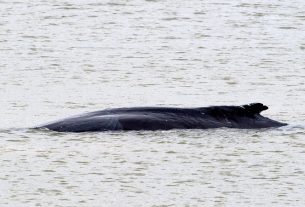Named A68, the world’s largest iceberg, is currently heading for the subantarctic island of South Georgia, where it could hit in less than a month. If it were to anchor to the seabed, then the structure could disturb the local wildlife.
In 2017, the Midas project, which brings together British researchers with the aim of monitoring area C of the Larsen ice barrier, east of the Antarctic ice cap, confirmed the news: a gigantic iceberg has just fallen. detach. Called A68, the structure, whose mass was close to one trillion tonnes, covered an area of 5,800 km² at the time. That is more than fifty times the surface of the city of Paris.
This “largest iceberg in the world” has not caused sea levels to rise. And for good reason, it was already floating on the water when it came off. The European Space Agency (ESA), on the other hand, explained that the iceberg could represent a danger for maritime traffic if it were to fragment into small pieces. A priori, the structure held up well. The iceberg has indeed shrunk a bit over the past three years, but it still remains a monster, measuring around 158 km long and 48 km at its widest point.
South Georgia Island insight
A68 worries researchers today for another reason. Indeed, recent satellite data suggests that the structure is heading straight for the British island of South Georgia. This is not the first. Many icebergs tend to follow this sea route leading them to the island.
In contrast, A68 is of a whole different caliber, especially since it is not very deep. According to data collected by satellite altimetry from its calving in 2017, researchers had estimated its thickness to be less than two hundred meters. “This measurement has not been repeated recently, so the current thickness must be a little thinner due to some melting that has taken place over the past three years,” emphasizes the spokesperson for the British Antarctic Survey (BAS).
This iceberg could become a problem for local wildlife
This is particularly what worries researchers. With such a thickness, it is indeed not impossible for the iceberg to anchor itself on the seabed. If this is the case, it would then disrupt the local fauna, cutting off the sea routes allowing some animals to feed. Seals and penguins in particular would then have to make huge detours to seek food, leaving their young even more unattended. It would also pose a problem for seabed organisms, which could find themselves “choked” by the invading iceberg.
The structure is currently located a few hundred kilometers southwest of the island of South Georgia. It is estimated that it could reach British territory in twenty to thirty days and be “stuck there” for almost ten years.
Note that a “collision” with South Georgia is not 100% certain. BAS remote sensing and mapping specialist Peter Fretwell estimates there is a 50% chance the iceberg will continue north instead of getting stuck.
If so, he predicts that the ice structure could loop around the southern end of the island, move up along the continental shelf, and then head northwest. Subjected to the force of the waves and bathing in increasingly warm water, it could then gradually disintegrate. Nevertheless, “it remains very difficult to say precisely what will happen”, concludes the researcher.



